Creative Container Garden Design Made Easy
Learn how container garden design requires two levels of design. On the macro level the containers are designed to fit into the overall garden and house landscape. On the micro level the content of each container is designed to form a mini garden in its own right.
Plants look magnificent in containers. Select plants and containers that compliment each other. Also take the color, theme and style of your home into consideration. Choose eye-catching plants that bring the best out of your garden and home.
Macro Level Container Garden Design
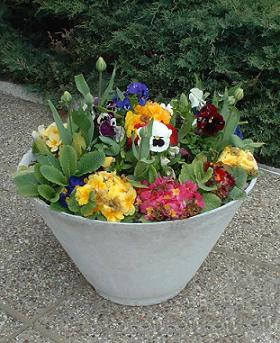
Follow established garden design principles to incorporate containers into your garden landscape. Containers add variety and interest to the garden, but form part of the harmonious whole. They should not dominate the landscape, but contribute to the overall effect. Containers can however be used as focal points.
Matching Containers
All the containers in your home and garden must match, and blend into their surroundings. The containers do not have to be of the same size and shape, but have to match in color.
Create unity within the design by using the same color containers throughout your container garden design. This also ensures continuity as you link the outdoors with the inside of your home.
The color of the containers could be the same as the tiles, walls, carpets or other common color in your home. You may also pick any other prominent color or complimentary color. Just remember the golden rule; keep to the theme of your home and garden.
Grouping of Containers
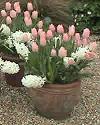
Grouping containers together creates good visual impact. Always group them in uneven numbers, i.e. 3, 5 or 7. Create a pleasing effect by grouping small, medium and large containers together.
Focal Point
Do not create too many focal points when you design gardens. This creates too many distractions and disrupts the flow of the garden. Use one large container, or a specific group of containers to keep a person’s focus.
If your focal point is not comprised of containers, make sure that the placement of any containers do not distract from the focal point. In this case blend your containers into the background.
Complementary Objects
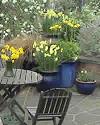
Complementary objects, like balls, can add additional interest to your container garden design. These objects will not have any plants in them, but their shapes enhance the visual effect of containers. Make sure that these objects have the same color, texture and finish as your containers.
Plant Boxes
Plant boxes can complement the architecture of a house. With proper design the house patio and garden can be linked together. The architecture can be extended into terraces, gazebos, patios, driveways, etc. on the outside of the house. The effect can be enhanced further by built in plant boxes inside the home e.g. an atrium.
[Return to Top]
Micro Container Garden Design
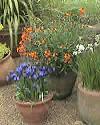
Designing the content of each container can be challenging yet tremendous fun. Each container is a miniature garden design on its own. All the design principles have to be adhered to on this small scale. The container plantings must also contribute to the larger garden around it. This makes container gardening so interesting
The plants and container must complement each other, just as a cooking pot and lid go together. For example; if you select a tall container, you need to plant a tall thin plant in it.
Round smooth leaves look good in curvaceous containers. Short square containers match short plants with fountain like leaves. They are also suitable for short, low growing plants.
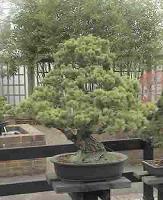
If you are really battling to select a suitable plant and container, go to your local nursery, and place a plant into the container. See if it is visually pleasing; if not select another plant. Carry on doing this until you get the perfect match.
Select suitable plants to under plant the main plant in the container. Choose plants that will complement the main plant (focus) of the container. As an example; a large container may be planted up with Iris and Crocus and under planted with Thyme.
This container will provide color for late winter/early spring. The deep purple colour of the Irises will complement the golden yellow of the Crocus. The under planting of Thyme (yellow variegated Thymus serpyllum Goldstream) will pull the design together. The Thyme also acts as a type of a ground cover to prevent the container from drying out.
This container will do best in a sunny position and need free draining compost. Visit our
container gardening plants
page for more plant combinations suitable for container garden design.
[Return to Top]
Attention: This is limited to the next 7 lucky individuals
“The FREE Shed Plan and Garden Improvement Project ”




